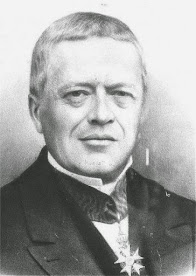Given these assumptions, suppose there are two mineral water springs exploited by two firms, A and B. The market demand curve is DD1, and its marginal revenue curve is MR, as shown in Figure 1. The marginal costs of both A and В are assumed to be zero so that they coincide with the horizontal axis. Suppose firm A is the only producer in which case it produces and sells OA (=½ OD1) quantity when its MR, equals its marginal cost curve (horizontal axis) at point A. It charges the monopoly price AS (=OP) and earns ОASP as monopoly profits.

Now firm В enters the market and expects that A will not change its output level OA. It, therefore, regards the SD1 segment of the market demand curve as its demand curve. Its corresponding marginal revenue curve is MR2 which intersects the horizontal axis (its marginal cost curve) at point B. Thus it produces and sells AB (= ½ AD1 = BD1) quantity at BG (=OP1) price and it expects to earn BGTA profits. Firm A finds that with the entry of B, the price has fallen to OP1 from OP. As a result, its expected profits decline to OP JA. In this situation, it tries to adjust its price and output. Accordingly, assuming that В will continue to sell the same quantity AB (=BD1), it regards the remaining portion of the market OB available to it. It thus sells ½OB. The reduction in its output from OA (=½OD1) to AB (= ½ OB) causes the price to rise (not shown in the figure to simplify the analysis). As a result of A’s reduction in output, В thinking that A will continue to produce less reacts by increasing its output to ½(OD1-AB) which causes the price to fall. In this way, A’s reducing its output and causing the price to rise, and B’s reaction in increasing its output and causing the price to fall will ultimately lead to an equilibrium price OP2. At this price, the total output of mineral water is OF, which is equally divided between the two firms. Each duopolist sells 1/3 of the market i.e. A sells ОС and В sells CF. At this price, A’s OCLP2 equals that of B’s profits CFRL. It is evident that both the producers sell 2/3 of the total output, OD1 and each is producing 1/3 of OD1.
Under Perfect Competition:
Let us compare the Cournot duopoly solution with the perfectly competitive solution. The duopoly firms A and В in equilibrium charge OP2 price and sell OF output. Under perfect competition, the total output will be OD at zero prices. The price is zero because the marginal cost is zero. When the MR1 curve intersects the horizontal axis, which is the MC curve, the price is zero at point A in the figure.The total output OD1 will be divided between A and В equally as OA and AD1 Notice that in the Cournot solution, the price OP2 exceeds the zero marginal cost and zero prices under perfect competition, and the output OF is less than OD1 under perfect competition. However, in the Cournot solution, the output (OF) is greater than it would be under monopoly (OA). But the price under monopoly (OP) would be higher than under the Cournot solution (OP2).
Conclusion:-
The Cournot model can be extended even to more than two firms. As more and more firms enter the oligopoly industry, the equilibrium output and price of the industry will approach the perfectly competitive output OD1 and the zero prices.
Its Criticisms:
The Cournot model has been criticized on the following grounds:-
(A)The main defect in Cournot’s solution is that each seller assumes his rival’s supply is fixed, despite repeatedly observing changes in it. Joseph Bertrand, a French mathematician, criticizing Cournot in 1883 pointed out that seller A in order to regain all the customers lost to B, will fix a price slightly below that fixed by В, and price cutting may continue until the price becomes zero. Thus, Bertrand argued that there would not be any limit to the fall in price since each seller could by doubling his produce, underbid his rival. This would tend to drive down the price to a competitive level in the long run.
(B)The model is silent about the period within which one firm reacts and adjusts its output to the moves of the other. Thus it is a static model.
(C)The Cournot solution is unrealistic because it assumes zero cost of production.
D)It is a closed model because it does not allow the entry of firms.
(E) The assumption that each duopolist can act without any output reaction from the other is unrealistic. It is, in fact, a no-learning-by-doing model.
(F) Marshall, therefore, regarded Cournot’s model as “incapable of a universal solution.” This is because it is not possible to find an actual duopoly market where each duopolist acts autonomously and output is the ‘sole parameter of action’.




nicely elaborated and very informative article on the oligopoly model.
ReplyDelete